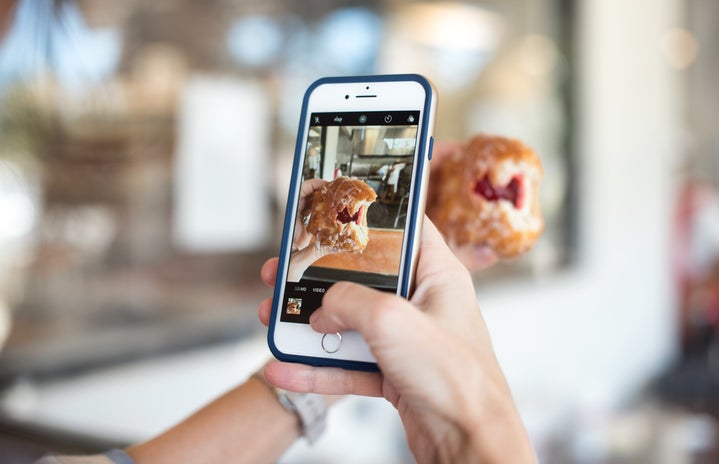The lobby lounge of The Citizen Hotel was ornamented with book shelves that made it look like a pre-19th century gentlemen’s parlor. People dressed in plain, white T-shirts and blue jeans shuffled around the red, brown, and black decorated room. The color décor of the room matched the temporary tattoos that people were sporting on their cheeks for the No H8 campaign.
Co-founder of the No H8 campaign and renowned photographer Adam Bouska held an open photo shoot in Sacramento, where people could join the movement for equal rights. This photo shoot was sponsored by Sacramento’s Rainbow Chamber of Commerce (RCC). To be professionally photographed cost $40, but a portion of the proceeds from this event went towards RCC’s scholarship fund for LGBT students.
People filled out model release forms and as they turn these forms in they were handed temporary tattoos with the words “No H8” in black and red and a call number. The campaign photos dictate that the temporary tattoo with the words “No H8” be placed on the cheeks while a silver strip of duct tape was place over the mouth. Once tagged with numbers, they moved from the lobby into an adjacent hallway where they waited for their number to be called so they can have their picture taken.
The busy event attracted local vendors selling drink cocktails and gourmet street food and desserts. While waiting, people gathered around and talked in this friendly atmosphere as the smell of street tacos permeated the air.
Heather Shaw, 34, placed the black and red “No H8” tattoo on her eight month old daughter, Jenni. “It’s trickier than I thought it would be,” Shaw said. Her daughter squirmed in her white onesie as Shaw placed a moist towelette on her cheek to imprint the temporary tattoo.
“I wanted her [Jenni] to be a part of this,” Shaw said, “to teach her how important it is that no matter who or what you are you are able to love freely.”
Once numbers were called, people moved from the waiting room into the conference room. People went to another desk to pay their fees and in exchange they were given their strip of duct tape. As the queue slowly moved through the hallway into the conference room, the sound of people chatting faded and was replaced by the camera’s lightning-fast shutter.
Myki Angeline, 44, posed with her partner Janette Vandergriff, 48. Dressed in the uniformed white shirt and blue jeans, they posed against a white backdrop in the conference room. The large room had a corner reserved for the photo shoot with lights and a photographer’s station with computers set up to quickly download the shots.
Angeline’s short spiky blue hair contrasted to the white, red, and black theme of the event. But in their pose, Vandergriff placed her hand on it, brushing through it. People are free to choose their pose, and Angeline and Vandergriff turn to face each other, their tattooed cheeks to the photographer as they gaze into each other’s eyes.
“We wanted the photo to show how much we are in love, even if we can’t physically say it,” Angeline said.
“The duct tape symbolizes how hard it is for gay or lesbian people to speak up about their feelings. I hope that by being a part of this [campaign] shows others it’s okay to feel what you feel and to talk about who you love freely without judgment or discrimination,” Vandergriff said.
Adam Bouska quickly processed people by taking ten frames per person or group. Then once finished, he would look down at his camera, check behind the computer screen quickly, before returning back to his original position, ready to take pictures of the next group.
Leon Fairly, 58, stripped off the duct tape and rubbed his hand over his mouth. “This is my second time doing this, but I forget how badly it hurts to rip off that sucker,” Fairly said, “I was inspired to come to support my brother and his partner the first time I did this, but now I would like to continue coming just to show general support for the cause.”
With new media tactics in play, Tiffany and Co. released their first ever same couple campaign for jewelry this Valentine’s Day. A pair of men are shown on the steps in front of a Brooklyn townhouse, advertising for wedding bands.
When asked about the media portrayal of same sex couples in Valentine’s Day adverts, Shaw replied, “There isn’t enough of them!”
“I think it’s good that they show same-sex couples in advertisements that are obviously advertising love. It’s just wrong to not depict all types of love,” Vandergriff said.
“I hope in the future we’ll see more advertisements with same-sex couples and we’ll see more acceptance to these commercials in our society,” Fairly said.
Valentine’s Day is often targeted towards one type of couple, but the people participating in the No H8 campaign hope to change the perspective that love comes in one form. The campaign promotes the advancement of equal human rights for the LGBT community as well as promote the beauty of love between all types of couples.

